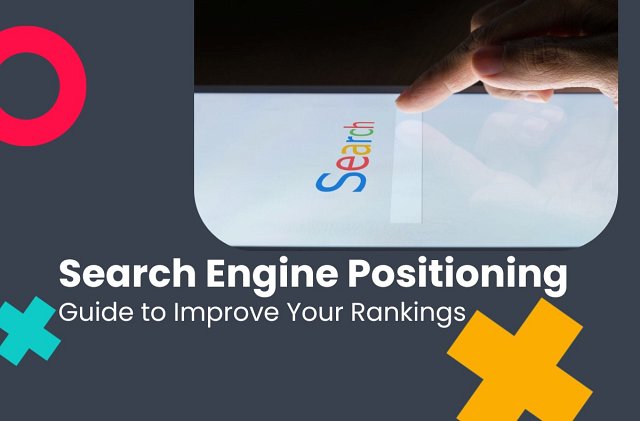(12 min. read)

What is Search Engine Positioning?
Search engine positioning refers to the practice of optimizing specific web pages to improve their visibility and ranking in the search engine results pages, or SERPs. Unlike broader search engine optimization (SEO) strategies that focus on increasing a website’s overall discoverability, search engine positioning focuses on ranking for specific keywords and phrases relevant to your business profile for each page.
This targeted approach helps your site appear more prominently for searches most likely to drive relevant traffic and potential customers. It involves a combination of on-page and off-page optimization techniques, from refining your website content and enhancing site structure to building quality backlinks.
Use these techniques effectively, and you’ll significantly improve your website’s search engine positioning, making it much easier for your target audience to find you in the vast ocean of online content.
What is the Difference Between Search Engine Positioning and Search Engine Optimization?
Search Engine Optimization is a comprehensive field that includes all activities aimed at improving your website’s overall visibility and ranking on a given search engine. It involves a wide range of techniques and strategies, including general technical website optimization and broader keyword research. The main goal of SEO is to increase the quantity and quality of inbound traffic to a site as a whole.
Search Engine Positioning, on the other hand, is more focused and specific. It concentrates on optimizing web pages by fine-tuning their content and employing highly selective strategies, targeted at ranking highly for concrete search queries. The goal here is not just to attract more traffic, but to attract the most relevant traffic. This involves understanding the intent behind searches and making sure your pages offer better content than other similar sites.
How Do Search Engines Determine a Page’s Position?
Before you can improve your page's search engine positioning, you’ll need to understand how search engines like Google determine a page’s rank in the search results. Google uses complex algorithms that include over 200 factors (specific number not disclosed) to rank web pages. These factors can be broadly categorized into three main areas:
- Relevance: Google’s main goal is to provide the most relevant results to each user’s query. This is primarily determined through keywords and content — when a user types in a query, Google scans its index to find pages that contain the same or similar keywords. It’s not just about the frequency of these keywords, but also their context and placement.
- Authority: Google assesses the authority of web pages based on several factors, with backlinks being a primary indicator. Backlinks are links from other websites to your site, and for Google, if other reputable websites link to your content, it must be valuable and authoritative. The quality of backlinks is more important than quantity; links from high-authority sites are more beneficial than numerous links from lesser-known, low-quality sites.
- User Experience: Google increasingly prioritizes user experience in its ranking algorithm, including factors like mobile-friendliness, page loading speed, ease of navigation, etc. Websites that are easy to use and load quickly tend to rank higher, but user engagement metrics like time spent on site, bounce rates, and click-through rates also play a role.
Apart from these main categories, other factors like website security (SSL certificates), structured data, and local SEO (for location-based searches) can also influence a page's position. Google continuously updates its algorithms, meaning the specifics of these ranking factors can change.
Improving Search Engine Positioning
Improving your search engine positioning is a multifaceted process that involves various strategies and practices — here we break down this process into nine key areas, each important for boosting your pages’ visibility and ranking in search engine results pages.
Choose the Right Keywords
Start by identifying the needs and interests of your target audience for each page. What are they searching for? What specific terms or phrases might they use in their search queries? It’s recommended to use tools like Google Keyword Planner, SEMrush, or Ahrefs to find keywords related to your niche. They provide valuable data on search volume and competition, as well as current trends.
Focus on long-tail keywords — they are longer and more specific phrases that might have lower search volume, but can attract more qualified traffic and have less competition. Pay attention to keyword difficulty scores provided by SEO tools. Aim for a mix of high-competition keywords and those that are less competitive to build a balanced strategy.
Perform Competitor Analysis
Look at the keywords your competitors are targeting. Tools like Ahrefs’ Site Explorer or SEMrush’s Competitive Positioning Map can give insights into the keywords driving traffic to their sites. Identify both the high-competition keywords they rank for and any niche opportunities they might be missing.
Review the type, quality, and comprehensiveness of your competitors’ content. Are they using blog posts, videos, infographics? What topics are they covering? How in-depth is their content? This can give you ideas for content gaps you can fill. You can also examine their backlink profile using tools like Moz’s Link Explorer — understanding who links to your competitors can help identify potential backlink opportunities for your site. Look for patterns in the types of sites linking to them and the content that is attracting the most links.
Evaluate their website's structure and user experience. How is their site navigation? What is their site speed? How mobile-friendly is their website? These factors influence SEO, and understanding your competitors' strengths and weaknesses in these areas can inform your strategy.
Build Topical Authority
Building topical authority involves establishing your website as an expert source of information in a specific niche. It's about creating a reputation for expertise and reliability around subjects closely related to your business, which will help your pages rank higher in search results.
Clearly define the niche or subject area where you want to establish authority. It should align closely with your business, products, or services. The more specific your niche, the easier it will be to become a recognized authority. Develop in-depth content that covers various aspects of your niche. Your content should be well-researched, informative, and provide real value to readers. This can include blog posts, whitepapers, guides, infographics, etc.
Use tools like Answer the Public or Google’s “People also ask” feature to find common questions in your niche. Create content that directly answers these questions. This not only builds authority but also improves your chances of appearing in featured snippets.
Cite reputable sources and collaborate with industry experts. Guest blogging, interviews, and joint webinars can expand your reach and build credibility. Also, remember to engage with your audience through comments and social media — the engagement can provide insights into new content ideas and foster community around your brand, increasing customer retention and online following.
Update Your Content Regularly
Regularly updating your content is a vital search engine positioning strategy for maintaining and improving your website's search engine positioning efforts. Fresh, updated content signals to search engines that your website is relevant and providing current information.
Conduct a regular audit of your existing content to identify pieces that are outdated, underperforming, or no longer accurate. Tools like Google Analytics can help identify pages that may need updates. Update statistics and references to make sure they reflect the most current data. This is particularly important for industries where information changes rapidly. During the review, look for broken links you can fix. Broken links are links that point to non-existent resources — change them to link to working pages instead.
SEO trends and algorithms change over time. Revisit your content to ensure it aligns with the latest SEO best practices, including keyword usage, meta tags, and internal linking. If relevant, expand your content to cover new topics or subtopics that have emerged since the original publication date.
Once your content is updated, promote it through your marketing channels. This could include social media posts, email newsletters, or even a mention in a newer blog post.
Optimize For Featured Snippets
Featured snippets are selected search results that are featured on top of Google's organic search results below the ads in a box. Optimizing web pages for these can significantly increase visibility and click-through rates.
Look for questions commonly asked around your topic, and structure your content to answer them directly and concisely. Use headers (H2, H3, etc.) with the exact question you’re answering. Directly below the heading, provide a clear and concise answer. Aim for an answer that's approximately 40–60 words for paragraph snippets.
When applicable, use bullet points or tables to present information. This is especially effective for step-by-step instructions, lists, or data comparisons. While answering questions, naturally incorporate relevant keywords. This helps search engines connect your content with the right queries.
Optimize Your Meta Tags
Meta tags are snippets of text that describe a page's content; they don't appear on the page itself, but are part of the page's code. Your meta title tag is responsible for your page’s title as it appears in SERPs — and the meta description tag for the text below.
Properly optimized meta tags are crucial for search engines and users to understand your page content, which can significantly impact your search engine positioning. Keep your title tags under 60 characters to make sure they display correctly on SERPs, and include your primary target keywords towards the beginning of the title to encourage clicks.
The meta descriptions provide a brief summary of the page content. While it doesn’t directly influence rankings, a well-written meta description can improve click-through rates. Limit your meta descriptions to 160 characters, and integrate your primary target keyword and related keywords naturally.
Header tags, which we already mention, also contribute to better search engine positioning. The H1 tag is the main header and should include the main keyword, while H2s and H3s are used to structure the content and should include a secondary target keyword where relevant.
Consider using schema markup wherever applicable to help search engines return more informative results for users. It’s a form of code that communicates the details of your page and its elements to search engines, allowing it to appear in special snippets. The code can be written using HTML tags and attributes, but Google prefers a JSON-LD format.
Be careful not to overstuff your meta tags with keywords. Use them sparingly, or else Google might penalize your page for placing too many key phrases and trying to influence rankings unfairly.
Use Internal Linking
Internal links are used for linking to other pages on your own website in your content. They help distribute page authority and ranking power throughout your site, but it’s also a useful navigation tool for both users and search engines.
Create internal links between pages with related content. The clickable text in a hyperlink (anchor text) should be descriptive and include a relevant target keyword. This helps both users and search engines understand what the linked page is about. Using a keyword-rich anchor text is recommended, but be careful of overstuffing.
When publishing new content, go back to your older relevant content and add internal links to the new pages. It’s a useful way of adding new value to the content that has already been published, keeping it fresh and helping spread link equity.
Consider adding “breadcrumbs”, or navigational aids like hierarchical category links that show users their current location on a site. If your pages have complex structure and are several categories deep, breadcrumbs are useful for both users and search engines to better grasp your site’s structure.
While internal linking is beneficial, too many links on a page can be overwhelming for users and dilute the value of each link. Keep the number of links reasonable and focus on linking where it is most useful.
Technical Optimization
Page loading speed is a critical ranking factor. Use tools like Google's PageSpeed Insights to identify how you can speed up your site. This may include optimizing images, leveraging browser caching, minimizing JavaScript and CSS files, etc. Using the Google Search Console, you can perform a Core Web Vitals performance report that will help you pinpoint problem areas important for Google’s positioning, including mobile performance.
Create an XML sitemap that lists your website’s URL structure — it’ll make it easier for search engines to crawl your site. Make sure the sitemap is up-to-date and submitted through the Google Search Console (don’t forget to edit the file when you change the structure). A well-structured website, in general, helps search engines and users navigate your site.
The robots.txt file tells search engine crawlers which pages or sections of your site should not be crawled. Make certain it’s correctly configured to avoid unintentional blocking of important content. Use Google Search Console to check for crawling errors — addressing these errors quickly means that search engines can effectively crawl and index your site.
How to Check the Position of a Page in SERP?
Knowing where your pages rank in SERPs is essential for evaluating exactly how effective your SEO strategies are. Thankfully, there are several tools available that can help you monitor your page’s positioning without spending hours manually checking Google results.
Google Search Console is a free tool provided by Google to help you monitor and maintain your site’s presence in search results. It gives you powerful insights into how Google views your site, what queries bring users to your site, how often your pages appear in Google SERPs, your pages’ performance, and more.
For more in-depth analysis, SE ranking is an all-in-one SEO software that includes a keyword rank tracker, a website audit tool, a backlink monitor, SEO research tools, content marketing aids, and more. Platforms like Ahrefs or SEMrush also provide a wide range of digital tools that help webmasters adjust all aspects of SEO on their sites.
You can also use dedicated tools like SerpWatch that focus solely on tracking search positions — they can help you by monitoring rankings in real-time and sending you notifications for any position changes, making it easier to react quickly.
Use these tools and the knowledge you now have to monitor and improve how well your pages are performing in search rankings. Remember, a search engine positioning campaign is an ongoing process. By continually refining your strategies and staying committed to best practices, you can make sure that your website not only reaches, but maintains a prominent position in SERPs, helping you connect with your target audience and achieve your marketing goals.



